يو ايس جو جائزو
Hiring Cools as Trade War Heats Up
- Amid increasing trade tensions and fears of recession, all eyes turned to the nonfarm payroll release this morning, which showed employers added only 130,000 jobs in August. Hiring has certainly slowed since the start of the year, as the 12-month average change now stands at 173,000, compared to 235,000 in January (top chart).
- The United States confirmed on Thursday that the next round of trade talks with Chinese officials will take place in Washington in October. The trade war has now been ongoing in earnest for over a year, though the more recent escalation has pushed measures of trade uncertainty to lofty levels.
Hiring Cools as Trade War Heats Up
The United States confirmed on Thursday that the next round of trade talks with Chinese officials will take place in Washington in October. Global markets gained on the news. A successful deal at the conclusion of the talks could result in a walk-back of tariffs on both sides, though that outcome remains elusive. Chinese officials continue to urge the U.S. to remove sanctions on technology company Huawei, while the U.S. demands intellectual property reform and a sustained market for its agricultural exports. With large demands from both sides, we maintain the view that the U.S. will follow through with its proposed tariffs (top chart).
The trade war has now been ongoing in earnest for over a year, though the more recent escalation has pushed measures of trade uncertainty to lofty levels (middle chart). The business environment remains ambiguous and activity is faltering as a result. The ISM manufacturing index fell below 50 in August for the first time since 2016, as more firms reported a contraction than an expansion in manufacturing activity. The decline in the new orders subcomponent was even more worrisome. At 47.2, new orders tied the cycle low set in 2012, and suggests activity will remain subdued in coming months. The service-side of the economy held up fairly better in August with the ISM nonmanufacturing index rising to 56.4, but we do not expect the services sector to remain unscathed. As more consumer products come under tariffs in coming month’s higher prices will erode purchasing power and likely lead to a decline in consumer sentiment, which may weigh on consumer spending.
The U.S. trade deficit narrowed $1.5 billion in July, as exports rose and imports were held back by a drop in capital goods imports— which echoes the weakness in the investment data. But, a gain in goods exports is unlikely to be sustained, as the ISM manufacturing export orders subcomponent slipped negative in July and moved even lower in August. This suggests, even before the more recent escalation in the trade fight takes hold, exports should slow further.
Amid increasing trade tensions and fears of recession, all eyes turned to the nonfarm payroll release this morning. Hiring slowed in August, as employers added 130,000 jobs, 25,000 of which were a product of the temporary 2020 Census hiring. Private hiring rose only 96,000 in August. Slower global growth and trade uncertaintiy have added to the pullback in private sector hiring in recent months, as some of the most trade-sensitive industries, like manufacturing, have seen hiring slow. But, services industries, like education & health and information have also reduced hiring. The job openings rate has edged lower and today’s report underscores weaker hiring since the start of the year. A bright spot in this morning’s report was average hourly earnings, which rose 0.4%, pushing the 3-month annualized rate up to 3.6% (bottom chart). But wage growth struggles to break out of its recent range. As tariffs permeate more industries, firms will have even less room to raise wages.
Consumer fundamentals remain in decent shape, but risks to consumer spending are elevated. We expect the Fed to get ahead of a more pronounced slowdown and cut rates an additional 25 bps at its meeting on September 18th. Officials are set to release new economic and interest-rate projections at the meeting, which will provide insight to its medium to long term outlook.
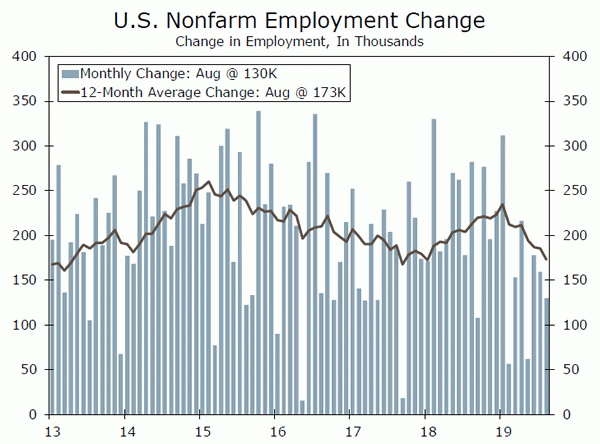
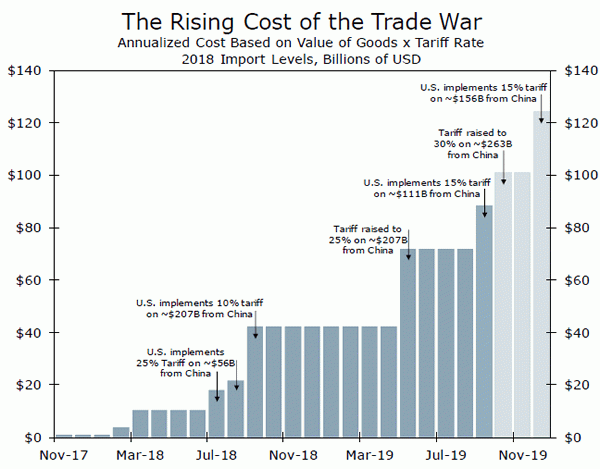
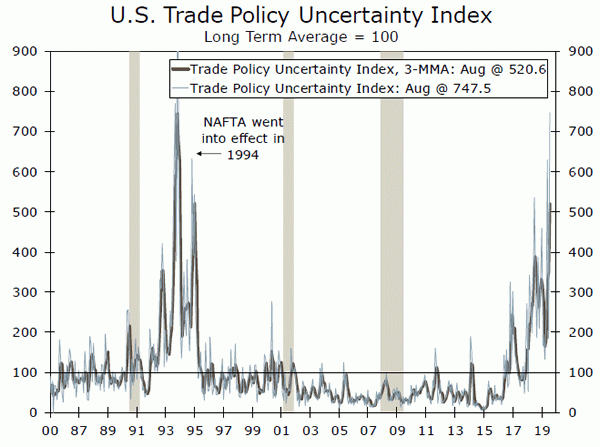
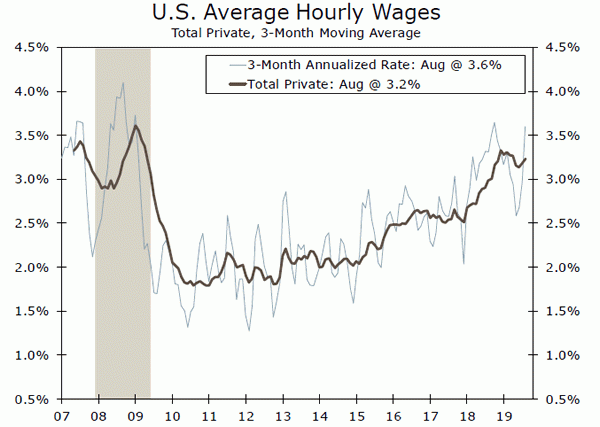
يو ايس Outlook
Producer Price Index (PPI) • Wednesday
The PPI index shows few signs of domestic producers taking advantage of any additional pricing power due to tariffs. PPI inflation has eased over the past year, with the headline index slowing to a 1.7% rate. Underscoring that softness, our preferred measure of core PPI inflation, which excludes food, energy and trade services (measured as margins), fell for the first time last month in nearly four years. With the exception of energy, input costs for processed goods and services fell in July and suggest producer price inflation should remain tame in the near term.
The PPI got a bump in July due to higher energy costs, but lower gas prices suggest only a 0.1% gain in August. That should keep the yearover- year change in producer prices below 2% and signal inflation is still not a threat to the Fed’s easier policy stance of late.
Previous: 0.2% Wells Fargo: 0.1% Consensus: 0.1% (Month-over-Month)
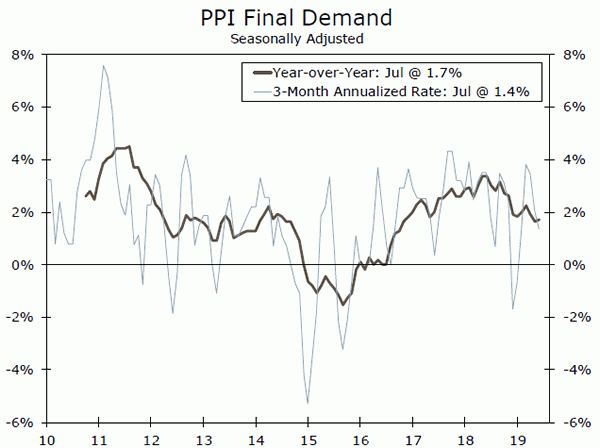
Consumer Price Index (CPI) • Thursday
Core CPI inflation has ripped higher over the past two months, registering back-to-back gains of 0.3%. The prior two months’ strength was helped by catch-up in apparel and used autos prices, with July getting an extra boost from the volatile hotel and airfare components. We expect to see those effects fade in August, but for core prices to still eke out a 0.2% gain. Including food and energy, we expect the CPI to rise only 0.1% due to lower gas prices last month.
Another surprisingly strong reading on core inflation is unlikely to sway the FOMC’s easing bias. We believe the Fed has grown more tolerant of 2%+ inflation as it desires to raise levels of inflation expectations. In addition, another above-trend print in core inflation would likely be tied to tariff pressures, which we suspect the FOMC would look through as it focuses on the downside risks to growth. A softer than expected print, however, would support the FOMC cutting rates again this month.
Previous: 0.3% Wells Fargo: 0.1% Consensus: 0.1% (Month-over-Month)
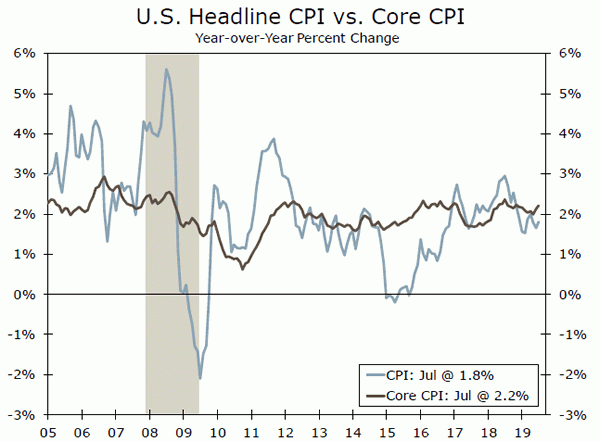
پرچون وڪرو • جمعو
Retail sales started the third quarter at a blistering pace. Total sales rose 0.7%, while “control group” sales, which excludes sales at gas stations, building material stores and restaurants, rose 1.0%. Overall sales were flattered, however, by the extension of Amazon’s Prime day. Therefore, we expect to see some payback this month, which along with lower gas prices should lead to only a scant gain in sales.
The August retail sales report will be poured over to gauge how consumer spending is faring in the wake of recent tariff threats and volatility in financial markets. Another solid report will be taken by the Fed as a signal that consumer spending is holding up in the face of global headwinds, and that the economy is not in much need of additional policy accommodation at this time. A big miss, however, would raise concerns that consumer spending cannot sufficiently offset the headwinds from slower global growth and trade uncertainty, and add urgency for the Fed to ease policy further.
Previous: 0.7% Wells Fargo: 0.1% Consensus: 0.2% (Month-over-Month)
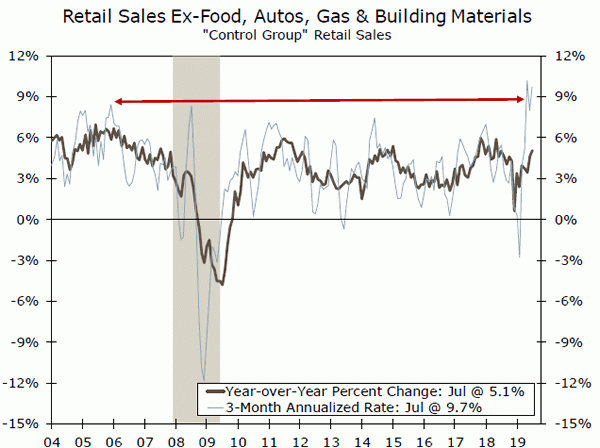
گلوبل جائزو
Summer Ends, but Brexit Keeps Things Hot
- The United Kingdom’s parliament returned to action this week, and with its return came another acrimonious debate about the future relationship between the United Kingdom and the European Union.
- As always, the number of possible outcomes going forward is numerous and nuanced. Broadly speaking, however, it appears increasingly likely that a national election in the U.K. will take place at some point before year’s end.
- The Bank of Canada (BoC) kept its main policy rate unchanged at its meeting this week, asserting that the economy is operating close to potential, inflation is on target and the current level of policy stimulus is “appropriate.”
Summer Ends, but Brexit Keeps Things Hot
The United Kingdom’s parliament returned to action this week, and with its return came another acrimonious debate about the future relationship between the United Kingdom and the European Union. At present, the U.K. is scheduled to leave the European Union on October 31. Boris Johnson, the newly anointed Prime Minister of the current conservative-led government, has stated that his government would prefer to leave the EU with a deal. That said, PM Johnson has also stated that, should a deal be unreachable, the U.K. would be forced to leave on October 31 with no deal.
This proved to be an untenable position for some members of his party, and a series of defections led PM Johnson to lose his razorthin majority. The defections occurred when some rebel Tories supported a Labour party-led vote asking for an extension past the October 31 deadline if a deal with the EU is not reached. In the face of this defeat, PM Johnson has called for an election to be held on October 15. A vote on an election at that time failed once, and a second vote is scheduled for Monday, though it too appears headed for defeat.
As always, the number of possible outcomes going forward is numerous and nuanced. Broadly speaking, however, it appears two scenarios are most likely. In scenario one, the motion for an election on October 15 passes, setting up a critical national election ahead of the October 31 Brexit deadline. Alternatively, PM Johnson will continue to try to reach a deal over the next six weeks, and if he comes away empty-handed, then the U.K. would likely request another extension, and, if granted, hold an election sometime in November. Regardless, it appears that the odds of an election in the United Kingdom at some point in the next few months have risen substantially. Such an election, should it occur, would likely be viewed as a de facto second referendum on Brexit.
Unlike the Federal Reserve or the European Central Bank, the Bank of Canada has thus far resisted striking an overtly dovish tone. The BoC left its main policy rate unchanged at its meeting this week, noting that “Canada’s economy is operating close to potential and inflation is on target.” Real GDP growth in Canada rebounded solidly in the second quarter (middle chart), and the housing market showed additional signs of stabilizing. The BoC statement was not entirely upbeat, however, as policymakers asserted that “escalating trade conflicts and related uncertainty are taking a toll on the global and Canadian economies.”
Against this backdrop, the BoC deemed the current level of policy stimulus “appropriate”. Markets appear less convinced, and are pricing in 36 bps of easing over the next 12 months. The recent strength in the Canadian economy is encouraging, and core inflation has been more resilient in Canada than it has in many other developed economies. That said, it is up for debate how long Canada can resist the rising tide of dovish monetary policy abroad, particularly if it leads to a significant strengthening in the Canadian dollar. BoC policymakers may refrain from easing policy out of a concern that too low rates will reignite the housing market and push already high household debt levels even higher.
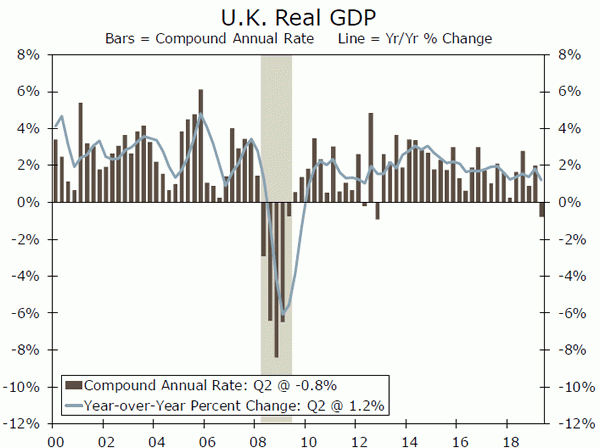
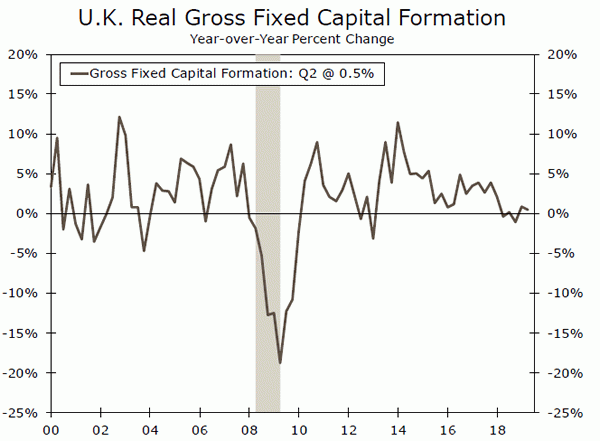
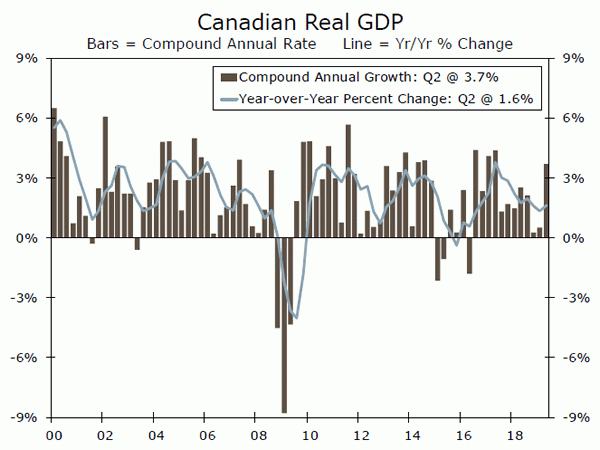
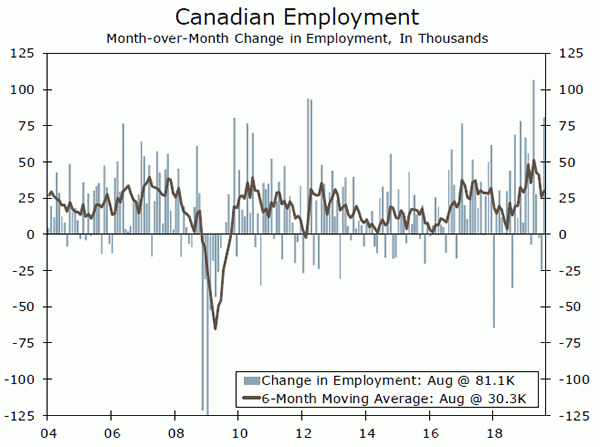
گلوبل Outlook
U.K. Industrial Production • Monday
As discussed in the international review section, the U.K. economy has decelerated, with particular weakness in the manufacturing sector. Weak external demand and a poor environment for domestic investment have been a challenging recipe for U.K. manufacturing. Through the 12 months ending in June, industrial production growth was -0.6%, and gross fixed capital formation was 0.5%. The initial release of IHS Markit’s U.K. manufacturing PMI for August was 47.4, down from 48.0 in July and the lowest reading since July 2012.
Although real GDP growth in the United Kingdom was negative in the second quarter, a big driver of this weakness was a drawdown in inventories that had been built up during the first few months of the year in advance of the original March 31 Brexit deadline. But, with it looking increasingly likely that Brexit will not be solved by the new October 31 deadline, the endless uncertainty could be creating more sustained headwinds for the U.K. economy.
Previous: -0.6% Consensus: -1.2% (Year-over-Year)
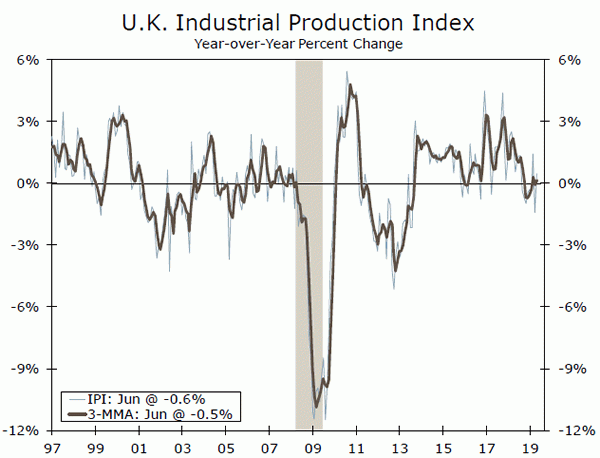
Mexico CPI • Monday
The sharp acceleration in Mexican prices starting in 2016 helped drive the Bank of Mexico’s main policy rate up more than 500 bps starting in late 2015. More recently, however, both headline and core CPI inflation have slowed and are now below 4%. The Bloomberg consensus is for headline CPI inflation to slow once again on a yearover- year basis in August, to 3.2%. Were this to occur, it would bring inflation close to the central bank’s 3% target for the first time since 2016, when the initial steep slide in the peso and the pick-up in inflation began.
Mexico’s economy has been under pressure of late, with real GDP outright declining 0.8% year-over-year in Q2-2019. This was the first negative year-over-year reading in Mexico since Q4-2009. Against this backdrop of slowing growth and inflation, the Bank of Mexico cut rates last month, and more easing may be in the offing in the coming months.
اڳيون: 3.8% اتفاق راءِ: 3.2% (سال کان مٿي-سال)
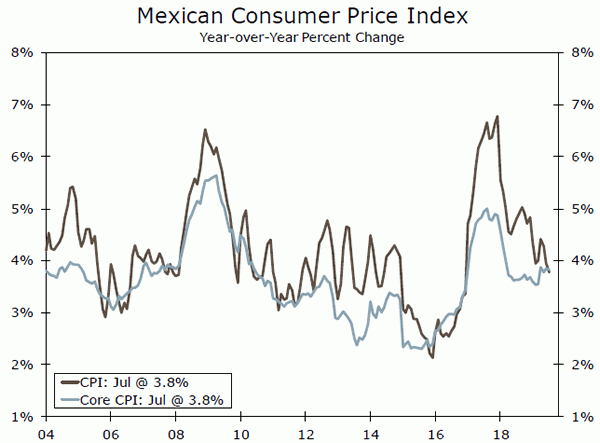
European Central Bank Meeting • Thursday
The European Central Bank (ECB) will meet next week in what is likely to be a crucially important meeting. The Eurozone economy has continued to tread water, with decent service sector data offset by a mightily struggling manufacturing sector. Thus far, these two forces have acted as roughly balanced counterweights, keeping the Eurozone economy out of a recession and allowing the ECB to stay on the sidelines. As more time has passed without a rebound, however, monetary policymakers have grown increasingly uneasy, particularly as political risks related to Brexit and Italy have reared their heads.
Our expectation is that the ECB will cut rates 10 bps and restart its QE program. Specifically, we expect the ECB to buy €45 billion a month in sovereign bonds for the next 12 months. Recent pushback against restarting QE from some ECB officials, however, makes the second portion of this forecast more uncertain than the first.
Previous: -0.40% Wells Fargo: -0.50% Consensus: -0.50% (Deposit Rate)
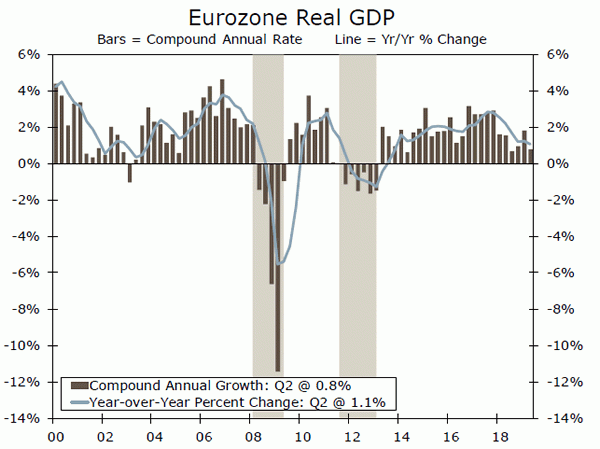
پوائنٽ جو نقشو
سود جي شرح واچ
Bond Yields Bottom, For Now
Barring another run of distressing economic reports, we have likely seen the bottom for bond yields. The yield on the U.S. 10-year Treasury hit 1.46% on Tuesday, following a weaker than expected ISM manufacturing report. That weakness stems from fallout from the U.S.-China trade standoff. The urge to stay ahead of rising tariffs led to a surge in inventories earlier this year, which has likely exaggerated the recent pullback in the new orders component of the ISM survey. Inventories are now diminishing, however, and a replenishment cycle might coincide with better news on the trade front.
The trade standoff clearly played a role in this morning’s soft nonfarm employment numbers, with hiring off in the transportation & warehousing sector. Job gains were fairly broad-based elsewhere, however, with construction posting a solid gain and hiring inching up in manufacturing.
The smaller than expected rise in nonfarm jobs will keep the Fed in an easing mode. We expect another quarter point cut in the federal funds rate at the September 18th FOMC meeting. The Fed’s language is likely to remain dovish until the economic data firm and there is a better feel for the downside risks of big global issues, such as the U.S.-China trade negotiations, Brexit and growth in emerging markets.
The past few days have brought a general sense of relief on nearly all fronts. A Chinese trade delegation is headed to Washington. The odds of a hard Brexit have diminished. There has been some easing in the tensions surrounding the Hong Kong protests, with the extradition law withdrawn. And a coalition government has been formed in Italy, which reduces the odds of an uncomfortable confrontation between the Italian government and the EU.
The surfeit of good news might seem to embolden the case of a handful of hawkish regional Fed bank presidents who appear reluctant to reduce the funds rate further. This hawkish stance is in keeping with the long-term role Federal Reserve Bank presidents have played in serving as a check against the politically appointed Federal Reserve Board members. The Fed’s political independence remains intact.
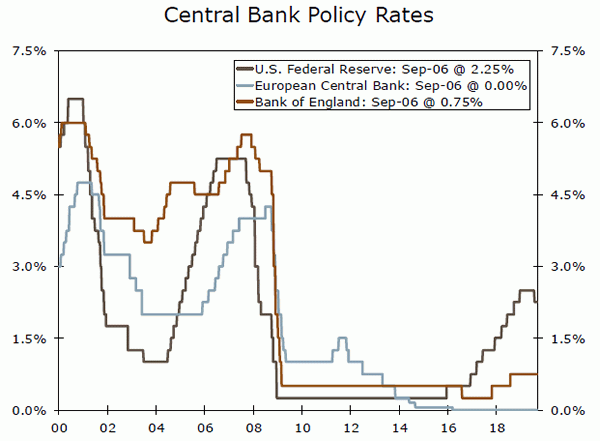
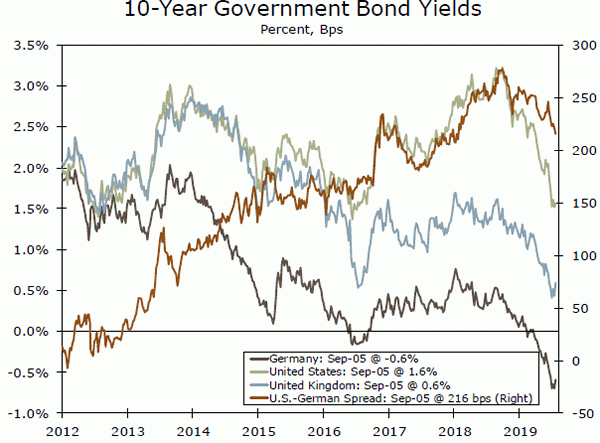
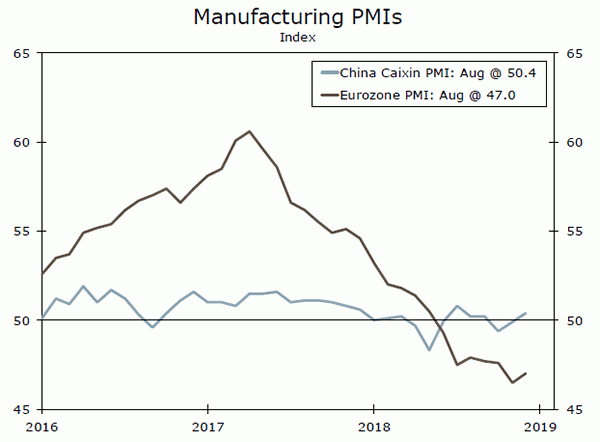
ڪريڊٽ مارڪيٽ بصيرت
Corporations Join the Refi Boom
Investment grade bond issuance hit a record this week, as companies borrowed $74 billion dollars as of Thursday. This is the highest amount borrowed in one week since records started being kept in 1972 and beats the previous record of $66 billion set in 2013. This spike in issuance comes as companies look to take advantage of the recent decline in interest rates. The yield on the 10-year US Treasury note fell roughly 50 bps over the course of August, and that fall was mirrored by corporate bond yields. After hitting 2.77% this week, the Bloomberg Barclays IG index yield is around its lowest point since 2016 and only 19 bps from its record low.
So far it appears companies are talking advantage of lower borrowing costs by refinancing, much like homeowners last month. While refinancing can lower debt service costs and free up cash for homeowners and corporations, it is not quite the same as residential or business investment. So far it seems that historically low costs of capital are not enough to entice investment. This is true of investment grade corporations as well as small businesses. In July, the NFIB asked small business owners if a 100 bps decline in the cost of capital would change their capital spending plans and only 12% said yes. Similarly, in the Federal Reserve’s Beige Book, access to capital seemed to be the least of businesses’ worries. The trade war and uncertainty, along with difficulty in finding new workers, continued to be front and center in the mind for business owners.
هفتي جو موضوع
Happy Trails…Until We Meet Again
The theme in this week’s purchasing managers’ surveys is that the service sector is doing fine and expanding at a faster pace even as manufacturing continues to struggle. How long can these two paths diverge?
Wall Street cheered the release of the ISM non-manufacturing index this week when that barometer of service sector activity came in at a better than expected 56.4 for August. That was up more than two points from where the index stood in July.
The sense of relief may have been somewhat more pronounced because just two days earlier the ISM manufacturing index surprised to the downside with a print of 49.1—the fastest pace of decline in the factory sector in just over three years.
One particularly worrying aspect of the factory report was the steep drop in orders activity. Both new orders and exports signaled the fastest pace of decline since the economy was in recession 10 years ago, as a number of respondents expressed frustration with the trade war. During 2015-2016 a retrenchment in manufacturing did not spill into the broader economy. Calling to mind that experience, it is tempting to conclude that the fallout from the trade war will disproportionately weigh on the nation’s factories, but the service sector and the consumer will be unscathed.
There is support for that argument at the moment, particularly given that core retail sales are growing at a three-month annualized rate of more than 4%. For a number of reasons though, we do not think that the service sector and the consumer will get off so easy this time.
A slowing global economy and collapsing commodity prices were the backdrop in 2015-16, and that helped real consumer spending via lower inflation. In contrast, today’s global slowdown is closely tied to the trade war.
We expect tariffs to push up inflation 0.1-0.2 percentage points in the coming months. Although not massive, it will erode purchasing power to an extent. With consumer sentiment already falling, real consumer spending will likely slow in the coming months, rather than continue to diverge from the path of factory output.
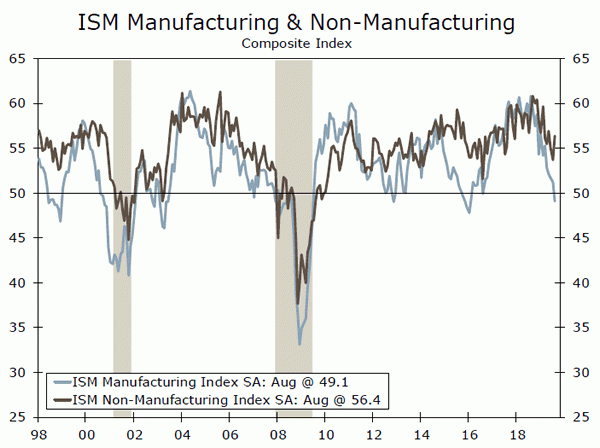
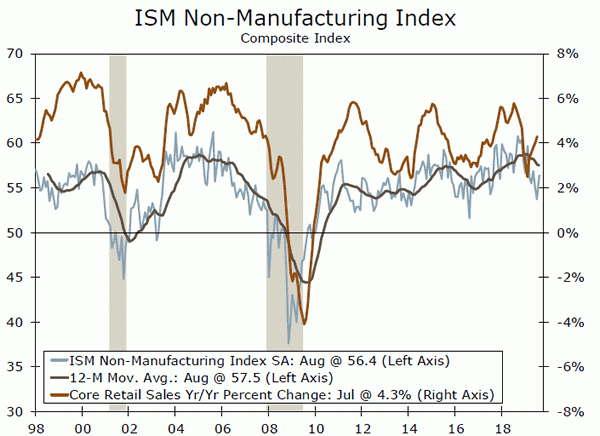

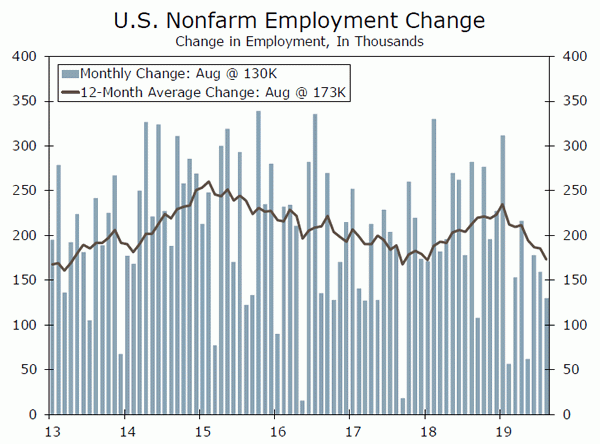
 Signal2forex.com - بهترين فاریکس روبوٽ ۽ سگنل
Signal2forex.com - بهترين فاریکس روبوٽ ۽ سگنل




